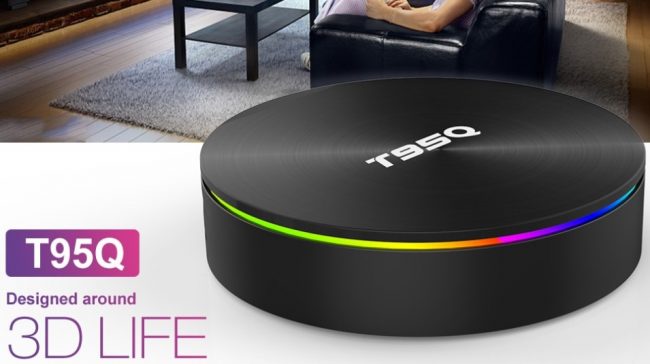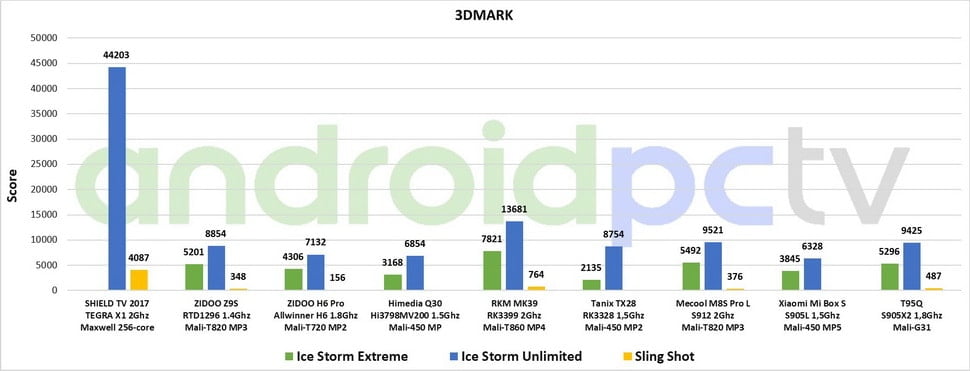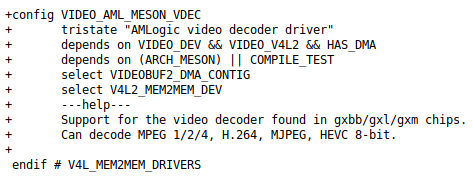Today we present our comparative and benchmarks of the new Amlogic S905X2 SoC against the all of current SoC in the market installed in the TV-Boxes. This new SoC is a Quad Core with ARM Cortex-A53 processors that integrates a Mali-G31 MP2 GPU and allows native H.265and VP9 video decoding up to 4K@75fps with support for HDR10, HLG HDR and Dolby Vision. A chip intended for the mid-range TV-Box that faces against the options of Alwinner, Rockchip, Hisilicon or Realtek.
Table of Contents
|
 |
ESPECIFICATIONS AMLOGIC S905X2
Test hardware
To perform the review of this SoC, we will use the TV-Box T95Q that integrates this new Amlogic S905X2 SoC. We have like memory 4GB of RAM, 32/64GB of internal storage eMMc, WiFi ac of double band with internal antenna and Bluetooth 4.2. In terms of connectivity we have a USB 3.0 port as a novelty, USB 2.0, microSD card reader, Gigabit Ethernet network connector, SPDIF audio, AV jack and an HDMI 2.1 port that allows 4K@75fps video output.
- The TV-Box T95Q can be purchased on Gearvita.com for only $59.99 (?53) including shipping.
 General specifications
General specificationsAs we saw in detail a few weeks ago in the specifications the Amlogic S905X2 SoC is a Quad core ARM Cortex-A53 CPU manufactured in 12nm, a significant improvement from the previous 28nm. It has native connections for HDMI 2.1 that reaches up to 4K@75fps compatible with multiple DRM security systems, USB 3.0 support, internal storage up to eMMC 5.0, Gigabit Ethernet and audio capacity up to 8 channels of audio input and output. In the graphical section we have an important jump in the GPU since now a Mali-G31 MP2 is integrated, which greatly exceeds the previous Mali-450MP5 of the S905X as we will see. In the videoplayback section the VPU now have an image processor called TruLife Image Engine Gen8 that allows us to decode the most modern video formats with HDR support.
 CPU
CPUThe new Amlogic S905X2 SoC Quad Core we have four ARM Cortex-A53 cores, it is capable of reaching 1.8 GHz and the manufacturing process is only 12nm which gives us performance improvements by lowering the consumption / thermals. As always in this type of products can limit the maximum speed, in our tests on this test model if we reach 1.8 GHz as maximum peak.
- As we see the system supports only ABI armeabi-v7a which limits us to install applications in 32bit
 GPU
GPUFor the graphical section we have a Mali-G31 MP2 GPU with a maximum speed of 650Mhz and performance up to 1.3 Gpix/s per core = 2.6Gpix/s (0.65 Gpix the Mali-450). It has support for OpenGL ES 3.2 and Vulkan 1.0, this GPU is made in 28nm HPM unlike the CPU cores that remain in 12nm. We also have support OpenCL 2.0 FP, Render Script, support L2 Cache up to 512MB and bus AMBA 4 ACE-LITE. With this GPU we can play powerful titles like PUBG in low / medium settings.
 VPU
VPUIn this SoC we find the TruLife Image Engine Gen8 video engine for decoding that supports h.265 and VP9 codecs, as well as HDR10, HLG, Dolby Vision and TCH Prime image formats. This system allows us to take video up to UHD 4K@75fps resolutions without problems thanks to its HDMI 2.1 video output that theoretically can be compatible with automatic refresh rate, but this will depend on the implementation in the firmware and the technology of our TV.
 Android system
Android systemThe system that we find in this first Box that we are going to analyze is based on Android 8.1.0 Oreo (API 27), the core that controls the system is kernel 4.9.76 with date of compilation 2018-11-09, a modern version and that luckily leaves behind the kernel 3 that we had in the models with Android 7 and S905X SoC. As we mentioned before due to limitations of the API, we can only install 32bit Android apps, perhaps to avoid incompatibility problems.
 PERFORMANCE TEST
PERFORMANCE TESTWe perform several performance tests with SoC Amlogic S905X2 and we make a VS against Soch Rockchip RK3328, RK3399, Nvidia Tegra X1, Realtek RTD1296, Amlogic S912, S905X (with its equivalent S905L), Himedia Hi3798CV200 and the Allwinner H6. Antutu
Possibly the best known test (we use version 6 for compatibility), with this benchmark we get an idea of the overall performance of the device and we can buy it with others. This test is very influenced by the internal storage and other values of general performance, as we can see in the results this new SoC is quite good and exceeds the S912.
 Geekbench
GeekbenchA test that gives us some very interesting values of the power CPU test in mono core and multi core in addition to computing by GPU. As we see in the results they are normal in monocore but in multicore we have a substantial improvement.
 3DMark
3DMarkThe graphical performance test par excellence with a fairly solid continuity in terms of results which helps us when comparing the performance of GPUs historically. As we see the GPU Mali-G31 MP2 performs well and exceeds the low range of its rivals and is at the level of the Mali-T820 MP3 S912 with a much lower consumption.
 PCMark
PCMarkThis test gives us an idea of the power level of desktop applications of this hardware performing tasks such as video editing, managing text or audio files, something that is increasingly used in Android. The result is a sum of all those aspects and is influenced by the general hardware components. The results are quite good and it is above the S912 thanks to the improvement in the efficiency of multitasking.
 Power consumption and thermals
Power consumption and thermalsWe also make a comparison of consumption and thermal at a general level, then we will see it in detail in the review of each device. As we can see the maximum consumption remains in only 5W as a result of the jump of manufacturing process from 28nm to 12nm. An excellent fivalue that give us much lower temperatures than in the S905X.
 CONCLUSIONS
CONCLUSIONSAs we have seen in our comparison the new Amlogic S905X2 SoC is a very interesting product that brings improvements at all levels compared to the S905X that we have seen in many TV-Box models and that will undoubtedly be the new SoC for the next Xiaomi Mi Box 5. The monocore performance is similar since we have the Cortex-A53 as the base, but the multicore efficiency has been almost doubled. Also now we have USB 3.0 support and also HDMI 2.1 that we expect evolutions in the next firmware. At the level of graphic power the Mali-G31 MP2 defends itself quite well and remains with good figures to allow gaming even in titles such as PUBG.
In this new Amlogic S905X2 SoC we also have interesting improvements in video playback with the TruLife Image Engine Gen8 video engine that as we will see in the specific reviews of each model allow us to fine tune the image quality, we have support for H.265 and VP9 plus all types of HDR including Dolby vision. At the audio level we also have interesting improvements in terms of decoding and also in voice recognition, something important with all the Virtual Assistant systems that we have in the market. No doubt a very positive generation awaits us with the new S905X2 and we hope to see soon his big brother the powerful S922X that is very promising too.

 The driver is written around the V4L2 M2M framework and currently supports MPEG 1/2/4, H.263, H.264, MJPEG, and (partially) HEVC 8-bit codecs. The driver has been tested with FFmpeg, GStreamer, and Kodi, and currently works on S905 (Meson GXBB), S905X/W/D (Meson GXL), and S912 (Meson GXM) processors.
The driver is written around the V4L2 M2M framework and currently supports MPEG 1/2/4, H.263, H.264, MJPEG, and (partially) HEVC 8-bit codecs. The driver has been tested with FFmpeg, GStreamer, and Kodi, and currently works on S905 (Meson GXBB), S905X/W/D (Meson GXL), and S912 (Meson GXM) processors.

Comment